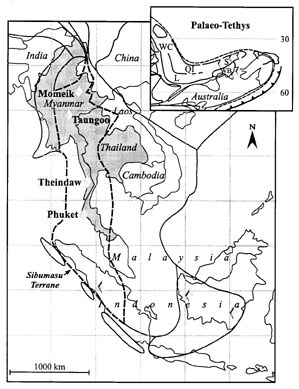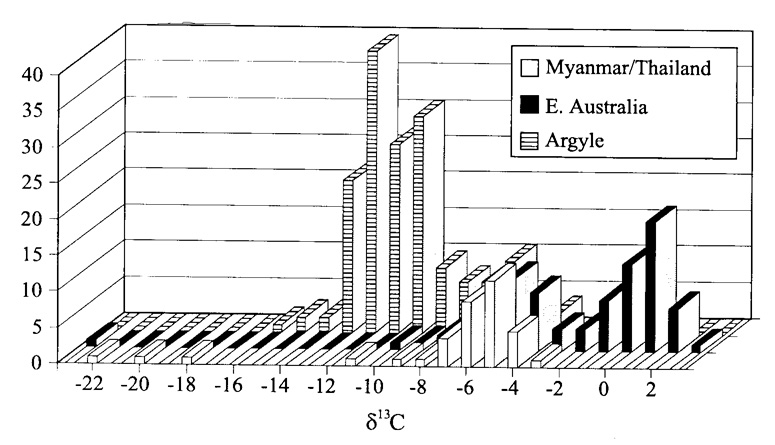Griffin, W.L.1,2, Win, T.T.2, Davies, R.2, Wathanakul, P.3, Andrew, A.4 and Metcalfe, I.5
1. GEMOC National Key Centre,Macquarie University, NSW 2109, Australia
2. CSIRO Exploration and Mining, North Ryde, NSW 2113, Australia
3. Faculty of Science, Kasetsart University, Bangkok, Thailand
4. CSIRO Div. of Petroleum Exploration, North Ryde, NSW 2113,
Australia
5. Div. of Earth Sciences, University of New England, Armidale,
NSW 2350, Australia
Alluvial diamonds with no obvious sources ("headless placers") are found
in several areas of Australasia, including Myanmar, southern Thailand (Phuket),
Sumatra, Kalimantan and eastern Australia (Fig. 1).
These deposits occur in relatively young geological terrains, in contrast
to the Archean or Proterozoic terrains that host most primary diamond deposits
and their associated alluvial workings.
 Fig. 1. Distribution of alluvial diamonds in SE Asia.
Sibumasu terrane outlined by thick dashed line.
Fig. 1. Distribution of alluvial diamonds in SE Asia.
Sibumasu terrane outlined by thick dashed line.
Inset: Permian plate reconstruction, showing location of Sibumasu
(S) and Western Burma (WB) terranes adjacent to NW Australia.
Significant quantities of diamonds have been recovered from two areas in Myanmar, Momeik in the northern part of the country, and Theindaw in the southern part, and from the Phuket-Takuapa area of SW Thailand. Smaller quantities have been found in several other localities, notably in the Taungoo-Htantabin area of Myanmar. The Momeik diamonds are recovered during mining of gemstone gravels; the Theindaw and Phuket diamonds are by-products of tin dredging. To understand the origin of these enigmatic diamonds and to provide an improved exploration model, we are carrying out detailed studies of the morphology, mineral inclusions, internal growth structures and growth history, nitrogen concentration and aggregation state, and carbon isotopic composition of diamonds from Myanmar, Thailand and eastern Australia.. We have examined >40 stones from Phuket, >110 from Theindaw and >25 from Momeik; these range in size from <0.1 ct to 3.5 ct, averaging ca 0.2 ct. While there are differences among the samples from different areas, the small sample size means these may not be representative, and the similarities among the samples are striking. They are therefore described together here. More detailed data are given by Win et al. (1998) and Wathanakul et al. (1998).
Physical Features
Most of the diamonds from both Myanmar and Thailand have rounded
forms and smooth, often glossy surfaces; octahedral stones with planar
faces are rare. Approximately 90% of the stones from all areas fall
in resorption categories 1 or 2 (dodecahedral or tetrahexahedroidal) of
McCallum et al. (1994). Fewer than 10% of the stones retain traces
of octahadral form (categories 3 to 4); 10-25% of the sample consists of
twinned crystals, including flattened macles which now are heavily resorbed.
Studies of internal structure by UV photoluminescence, cathodoluminescence
(CL) and birefringence reveal octahedral growth zoning in most diamonds.
This shows that the present strongly rounded forms are secondary, and reflect
resorption of the diamonds at high temperature, probably in the host magma.
This resorption has removed 25-60% of the original mass of most stones,
and produced a wide range of surface microstructures visible in SEM images.
Lamination lines, reflecting plastic deformation, occur on ca 70 % of the
Myanmar stones and 80% of the Phuket stones examined; more than one set
is commonly present. Aside from lamination lines, the most common
surface features are shield-shapped laminae, followed by hillocks, etch
pits and rare trigons. >50% of the stones have striking glossy surfaces,
which appear smooth even at high magnification in the SEM. Features
reflecting corrosion in near-surface environments include corrosion pits
and ruts. Abrasion during alluvial transport is reflected in a high
proportion of broken stones, abundant percussion scars and frosted edges,
and rhombic cracking. Brown (rarely green) spots, probably caused
by radiation from nearby U,Th-rich minerals, occur on 45% of the stones
examined. These spots, and others not seen in ordinary light microscopy,
appear on CL images as black spots fringed with yellow; ca 60% of the Myanmar
stones, and 70% of the Thai stones studied show this feature.
Some stones are colourless, but most range from yellow through
brown (the dominant colour) to deep reddish-brown (cognac); rare pink stones
are known, especially from the Phuket area. The brown colours, in
particular, are associated with plastic deformation, seen as lamination
lines on resorbed surfaces. Many stones thus show a characteristic oscillatory
blue-yellow CL pattern, and a high proportion show strong yellow CL colours.
This yellow colour also is seen along deformation planes, and appears to
be responsible for the yellow CL colour of nitrogen-rich zones within the
diamonds. Most diamonds show blue or yellow luminescence under UV
light, and several show blue cores and yellow rims. This latter feature,
and the yellow or yellow-blue oscillatory CL pattern, are uncommon in kimberlitic
diamonds but have been observed in stones from the Argyle lamproite in
NW Australia.

Fig. 2. Carbon-isotopic composition of diamonds from Myanmar and Thailand, compared to diamonds from Argyle and eastern Australia (Davies et al., this volume).
Chemical Features
Studies of syngenetic mineral inclusions
are in progress; those identified thus far are mainly of the peridotitic
paragenesis, and include olivine, chromite, Cr-pyrope and native iron.
Infra-red spectroscopy (FTIR) studies show that ca 15% of the Theindaw
diamonds have very low N contents (Type II diamonds); one Type II diamond
has been found in the Phuket samples and one at Momeik. In the other
stones, N contents range up to >1000 ppm, and average ca 500 ppm.
Nitrogen aggregation to Types IaB ranges between 10% and 80% and averages
ca 30%. In general aggregation state and N content are positively
correlated, but the correlation is poor. Many stones with high aggregation
states, including many with low N contents, show extensive plastic deformation,
which is believed to have enhanced the rate of aggregation.
Carbon isotope compositions of 37 Myanmar and Thailand diamonds
show a distribution similar to other diamonds worldwide. All values
of *13C from Phuket fall between -3 and -7 ‰. Most of the data
from Myanmar also fall in this peak, but 3 values spread from -7 to
-11 ‰, and 3 from -17 to -22 ‰. This pattern is distinct from that
of Argyle diamonds, which show a major peak between -8 and -13 ‰, and from
that of morphologically similar diamonds from eastern Australia (Davies
et al., this volume).
Possible Origin(s) of the diamonds from Myanmar and Thailand
Our data indicate that the Myanmar
and Thailand diamonds are derived from "normal" mantle sources, and probably
were brought to the surface by kimberlitic or lamproitic magmas.
They are not derived from metamorphic rocks, and there is no evidence for
a relation to subduction processes. The high incidence of plastic
deformation, yellow-blue oscillatory CL and "reversed" UV zonation, as
well as the highly polished resorbed surfaces, are more characteristic
of diamonds from lamproitic sources, rather than kimberlitic sources.
Features of breakage, surface wear and abundance of radiation-damage spots
attest to long periods of residence in alluvial systems.
The Myanmar-Thailand-Sumatra alluvial diamond localities lie
within the Sibumasu terrane (Metcalfe, 1996). Paleogeographic reconstructions
(Fig. 1) suggest that the terrane was detached from
NW Australia in Mesozoic time, and drifted northward to become part of
SE Asia. Its original location lay west of the Kimberley region with
its known diamond deposits. This region was glaciated in Permian
time, and Permian glacial sediments are found from Sumatra to northern
Myanmar, especially in connection with the Phuket and Theindaw diamond
occurrences. We suggest that the Myanmar-Thailand diamonds are derived
from primary sources on the Australian continent, or in the Western Burma
terrane while it was still a part of that continent, and secondarily from
the Permian glacial sediments. However, we cannot exclude derivation
from primary (lamproitic?) sources within the transported terrane.
The Kalimantan diamonds lie in another terrane with a different origin;
like the E. Australian diamonds, they may be directly or indirectly related
to subduction processes (Griffin et al., 1998).
References
Griffin, W.L., O’Reilly, S.Y. and Davies, R.M. 1998. Rev. Econ. Geol.
(in press)
Metcalfe, I. 1996. Aust. Jour. Earth Sci. 43, 605-623.
Wathanakul, P., Win, T.T., Davies, R. and Griffin, W.L. 1998.
Jour. SE Asia Geology, subm.
Win, T.T., Davies, R. and Griffin, W.L. 1998. Jour. SE Asia Geology,
subm.

 GEMOC ARC National Key Centre
GEMOC ARC National Key Centre